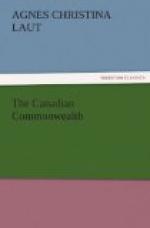In 1800 only four per cent. of the United States population was urban, and ninety-six per cent. was rural. By 1910 only fifty-three per cent. of the population was rural. Similarly of France and Great Britain. Sixty-five per cent. of France’s population is rural, and France is prosperous, and her people are the thriftiest and most saving in the world. They with their tiny savings are the world’s bankers. In the United Kingdom, the rural population has decreased from twenty-eight per cent. to twenty-three per cent. of the total population. How about Canada? In 1891 thirty-two per cent. of Canada’s people lived in towns and cities. By 1901 thirty-eight per cent. were town dwellers. By 1914 the proportion in towns and cities is almost fifty per cent.
The entire movement of population from country to city is reflected in the astounding growth of the cities. In 1800 Montreal had a population of seven thousand; in 1850, sixty thousand; by 1914, almost half a million. Similarly of Toronto, of Winnipeg, of Vancouver. From nothing in 1800, these cities have grown to metropolitan centers of three hundred thousand, and their growth is the subject of fevered civic pride. It ought to be cause of gravest alarm. In the history of the world, when men began to hive in a crowded cave life, those nations began to decline. The results are always the same—an extortionate rise in the cost of food, the long bread line, charity where there ought to be labor and thrift, food riots, terrible tragic contrasts of the very rich and the very poor, all the vices that go with crowded housing. When charity workers investigated in Toronto and Montreal and Winnipeg, they found foreigners living forty-three in five rooms, twenty-four and fifteen and ten in one. Wherever such proportions exist as to rural and urban population, ground rentals and values ascend in price like overheated mercury. Men begin to build perpendicularly instead of latitudinally. The cave life of the skyscraper takes the place of the trim home garden, and so greed of gain—interest on extortionate real estate values—takes its toll of human life and virtue, clean living and clean thinking. In one section of Canada during ten years, where there had been an increase of 574,878 in the country population, there was an increase of 1,258,645 in the city population. Between 1901 and 1911, where 39,951 newcomers settled in the country districts of Quebec, 313,863 settled in the cities. For one who chose life in the open, eight chose the tenement and the sweatshop. In 1901 Canada had 3,349,516 people living in the country, and 2,021,799 living in the cities. By 1911 there were 3,924,394 living in the country, and 3,280,440 living in the cities.




